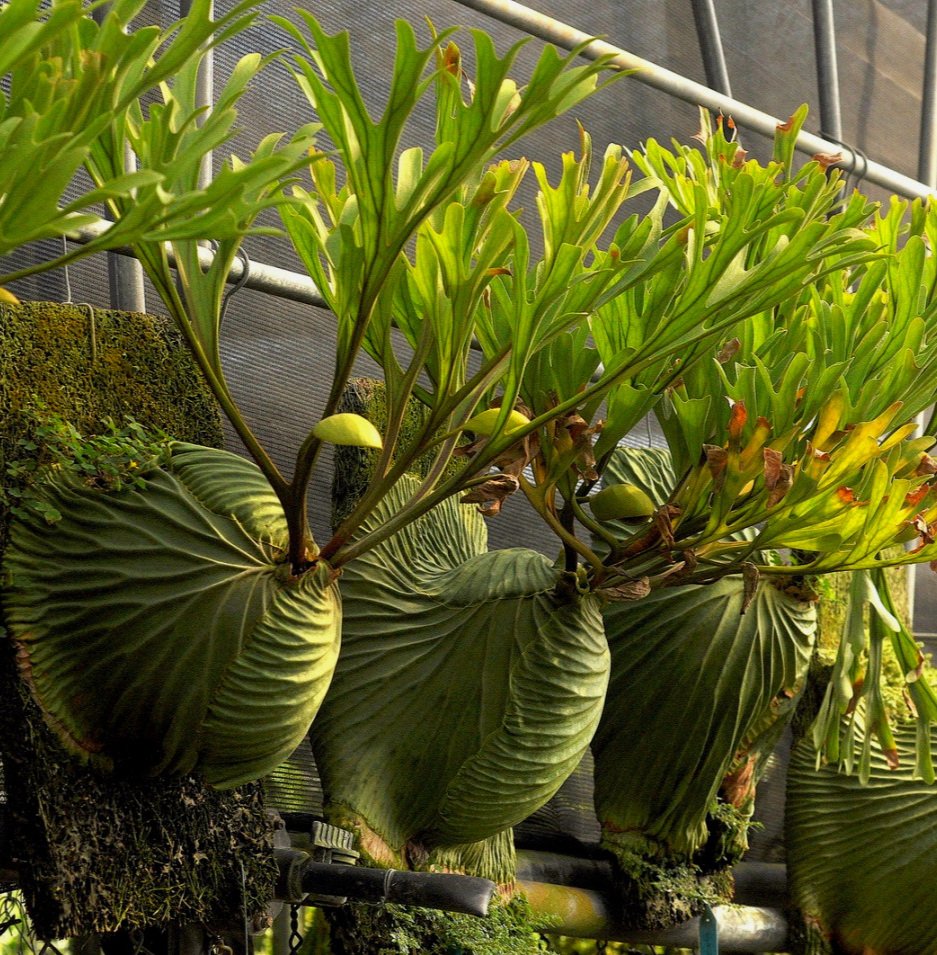
Why every collector has/wants a Ridleyi
Nature's architectural masterpiece
In the world of staghorn ferns, where dramatic forms and exotic beauty are the norm, one species stands apart from all others. Platycerium ridleyi—known simply as "Ridleyi" among those who speak its name with reverence—represents something extraordinary: a living sculpture that seems designed by an artist who understood both form and function in ways that defy botanical expectations.
This isn't just another rare plant. This is evolution's answer to the question: "What if a fern could be both architectural marvel and engineering genius?" The result is a species so visually striking that it has become the holy grail of staghorn collecting—commanding attention not through size or flashiness, but through the quiet confidence of perfect design.
The Architecture of Perfection
When botanists first encountered Ridleyi in the late 19th century, clinging to "perfectly inaccessible boughs of a lofty Shorea tree, 100 feet or more above the ground," [1] they struggled to categorize what they were seeing. Here was a staghorn that broke every rule about how staghorns should look and grow.
Where other species cascade like green waterfalls, Ridleyi stands upright with architectural precision. Where others sprawl horizontally, Ridleyi reaches vertically toward light, creating what growers describe as resembling "a bouquet of flowers" [2]—a living chandelier suspended in the forest canopy.
The genius lies in its three-dimensional structure. The fertile fronds don't simply emerge and droop under their own weight. Instead, they rise with mathematical precision, creating perfect radial symmetry that would make a geometric artist weep with envy. But these aren't merely decorative—they're sophisticated water collection systems.
The lower portions of each fertile frond are channeled, creating what European grower Simon Lavaud describes as a system where "when it rains, every raindrop is directed toward the rhizome, allowing the plant to be watered!" [3] Each frond becomes a living gutter, ensuring precious rainwater reaches the root system with remarkable efficiency.
At the tip of each frond hangs perhaps Ridleyi's most distinctive feature: the spoon-shaped spore pods. These elegant, three-dimensional structures—shared only with Platycerium coronarium among all staghorn species—dangle like botanical jewelry. When mature, they release spores "in mass," [2] creating dramatic clouds of reproductive potential that drift through the forest canopy.
The Beauty of Details
The shield fronds present their own aesthetic marvel. Unlike the smooth shields of other staghorns, Ridleyi's are deeply grooved and ridged, creating what collectors call a "waffle" texture. These aren't random patterns but sophisticated ecological adaptations—the grooves create "pre-galleries aimed at symbiotic ants that will establish their colonies under the shields." [3] The plant provides housing; the ants provide protection and nutrients.
This textural complexity gives the shields an almost sculptural quality. Light and shadow play across the deeply grooved surfaces, creating patterns that shift throughout the day. When properly mounted, mature plants develop "dramatic-looking, skirt-like shield fronds that drape down over the mount," [1] creating a layered effect where upright fertile fronds rise from cascading, textured shields—vertical drama meeting horizontal grace.
The overall effect is of a plant that seems designed rather than evolved. Every element serves both aesthetic and functional purposes, creating harmony between beauty and utility that represents the pinnacle of natural design.
The Legend and the Mystique
The story of Ridleyi's discovery reads like botanical adventure fiction. Around 1898, Anglican Bishop George Frederick Hose spotted this extraordinary fern growing impossibly high in Southeast Asian rainforest canopies. Sir Henry Ridley, for whom the species was named, could only observe from below, having "only been able to obtain fallen fronds" for study. [1]
This initial inaccessibility established a pattern that continues today. Ridleyi has never been easy to obtain. In its native range—spanning Myanmar, Malaysia, Thailand, Borneo, and Sumatra—populations have "reportedly declined substantially over the past ~40 years due to habitat loss and uncontrolled wild collection." [1] The species has been "considered locally extirpated in Singapore for many decades." [1]
The rarity extends beyond numbers. Unlike many staghorns that readily produce offsets, Ridleyi "does not offset and sporelings can be challenging to grow on from initial transplant." [1] Each plant represents not just a purchase, but a commitment to mastering one of staghorn cultivation's greatest challenges.
In Asian markets where Ridleyi is most appreciated, this rarity has translated into legendary status. Thai growers know it as "khao kwang bai tang," reportedly "extinct in the wild" in some provinces. [1] This precarious conservation status adds urgency to collecting—each specimen represents participation in preserving a species teetering on extinction.
The Cultivation Challenge
Ridleyi's temperament reflects its high-canopy origins, demanding precise environmental conditions that separate casual enthusiasts from dedicated experts. Having evolved "on top of trees" where it receives "fairly high light intensity," [3] this species requires bright conditions that would overwhelm many houseplants—but not harsh direct sun, rather the bright, filtered light of the forest canopy.
The plant's relationship with water reveals sophisticated requirements. Its channeled fronds capture rainwater efficiently, but this adaptation makes it "sensitive to drought"—"the sphagnum should never be allowed to dry completely." [3] It prefers pure water (distilled or rainwater) and thrives in high humidity environments of "80% RH and above." [3]
Temperature preferences reflect its canopy adaptation: optimal growth occurs between "20°C at night and 28°C during the day." [3] Air circulation proves crucial, as Roy Vail notes that since the species grows "high in the trees where air circulation is the best, air circulation is a key to its success." [2]
Perhaps most tellingly, plants "grown from spores from the beginning under our climate" prove "much easier to grow" than imported specimens. [3] This suggests that while Ridleyi maintains specific requirements, it can adapt if given the opportunity from a young age.
Why Every Collector Wants One
Ridleyi represents the intersection of beauty, challenge, and exclusivity that drives passionate collecting communities. It's not enough to simply want this plant—one must prove worthy through knowledge, skill, and persistence.
The aesthetic rewards extend far beyond plant ownership. This species transforms any space it occupies, creating a focal point that draws and holds attention. Its architectural form and sculptural presence make it as much artwork as living plant, while its constantly changing interplay of light and shadow ensures it never becomes mere decoration.
For collectors who appreciate historical dimensions, Ridleyi offers connections to botanical exploration's golden age and ongoing conservation challenges. To grow this plant is to participate in a tradition stretching back to colonial botanists while taking responsibility for preserving a declining species.
The global community of Ridleyi growers—from Taiwan's tissue culture laboratories to European LED-lit growing rooms—represents another dimension of appeal. The plant serves as common language among collectors who share appreciation for botanical excellence.
The Ultimate Expression
Every serious staghorn collector either has a Ridleyi or wants one because this plant represents the pinnacle of what their hobby offers. It combines rarity with beauty, challenge with reward, history with innovation. It's the plant other staghorns are measured against, the standard by which collectors judge their skills, the goal toward which every serious enthusiast gravitates.
In the world of Platycerium, where each species brings unique appeal, Ridleyi stands alone as the species that defines excellence. To understand why every collector has or wants a Ridleyi is to understand the very essence of pursuing botanical perfection—the desire for something that rewards dedication with daily beauty, challenges skills while building expertise, and connects us to both natural wonder and human achievement.
This is nature's masterpiece, and once you've seen it, understood it, grown it successfully, everything else feels like practice.
References
[1] Exotica Esoterica - Ridley's Staghorn Fern - Platycerium ridleyi. Available at: https://www.exoticaesoterica.com/magazine/ridleys-staghorn-fern-platycerium-ridleyi
[2] Halling - Platycerium Ridleyi. Available at: http://www.halling.com/platyceriums/Ridleyi.htm
[3] Cycadales - Basis of Platycerium ridleyi indoor cultivation in Europe. Available at: https://cycadales.eu/2021/09/17/bases-de-la-culture-interieure-de-platycerium-ridleyi-en-europe/?lang=en
Written by the team at Platy & Co. - Where passion for exceptional staghorn ferns meets cultivation expertise.
